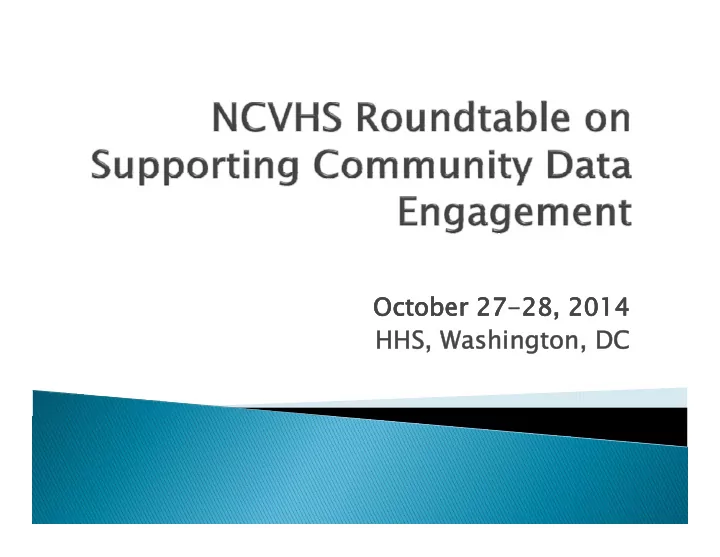

October October October October 27 27 27-28, 28, 28, 28, 2014 2014 2014 2014 HHS, Washington, DC HHS, Washington, DC
Part of a multi-year NCVHS effort to understand how communities can become learning systems for health Includes Includes online online s scans cans (feedback (feedback tools) tools) Operating definition of community : An interdependent interdependent group group of of people people who who share share a a set of characteristics and are joined over time by a sense that what happens to one member affects many or all of the others. (The Community as a Learning System, 2011, p. 7-9)
To bring together community leaders, health data connectors, and health data suppliers to identify major lessons, needs and gaps in local local data data access access and and use use, and and to explore how HHS can better support local data data efforts efforts.
‣ Sept-Oct 2014, 26 respondants, 27 questions ‣ Most common framework used f f k d f or C CHNA: MAPP ‣ Data gaps make it hard to evaluate PH impact, inventory community assets, y y , understand community priorities, identify modifiable factors. ‣ Respondants want more local data (current, large enough enough samples), samples), w web eb access access to to data, data, and and early early community input on what data need to be collected. ‣ ‣ Respondants Respondants want want the the feds feds to to allow allow greater greater access access to data, help assess neighborhood-level validity/accuracy, and provide accessible formats for for download download and and analysis analysis.
Communities: Sonoma County CA, Louisiana PH Institute Institute, D Douglas ouglas County County N NE E, S Seattle eattle Connectors: Community Commons, Healthy Communities Institute, County Health Rankings & Roadmaps, NAHDO, ASTHO, NQF, Kaiser Permanente, Catholic Health Assn., PHAB Data Data Suppliers: Suppliers: NCHS NCHS, SAMHSA SAMHSA, CMS CMS, A AHRQ HRQ, Healthy People 2020, VHA, ASPE Philanthropy: RWJF (Culture of Health Initiative) NCVHS (full Committee and/or Working Group): 12 members plus staff
Operating through cross-sectoral coalitions Shifting the frame from health to wellbeing Operationalizing a social determinants perspective Working for equity Engaged in Engaged in C CHNAs HNAs and and CHIPs CHIPs to to meet meet multiple requirements (IRS, PHAB, etc.) Shifting focus Shifting focus f from rom p programs rograms t to o p policies olicies Using ROI to make the case and engage decision-makers
Meaningful, actionable data (not just more data) Help using data for decision-making and action action (TA (TA, ‘data data concierge concierge’) In particular, more data on cost and on mental mental health/substance health/substance abuse abuse
Presentation is key (e.g., Portrait of Sonoma Count ) y Ongoing technical issues ― small area/small population population data data, privacy/disclosure privacy/disclosure, data data- sharing & linkage, timeliness, granularity, etc. Need Need to to get get non non-traditional traditional sources sources & & big big data on the radar
Local models ― evidence-based + innovative Collective impact, cross-sector & cross-level collaboration Key role of i l f ntermediari i di ies, connectors Federal initiatives (e.g., growing data sharing; regional regional “data data concierges concierges”; ; SDOH SDOH frame) frame) …. and much more (watch for the summary)
Promote community data literacy through listening, TA, strong data presentation Develop core sentinel indicators of local health/well health/well-being being, b backed acked by by a a reservoir reservoir of of data for decisions on agenda, interventions Align Align community community data data & s support upport platforms ― content, operations, funding Institutionalize community y voices in g gov’t decisions affecting communities ― all agencies and levels of government
Establish a community of practice Develop recommendations to the Secretary Convene a roundtable on community data literacy li Continue development of NCVHS Framework Facilitate Facilitate platform platform alignment alignment
NCVHS affirms the federal role in helping to meet communities’ data and TA needs. Celebrate Celebrate and and support support the the p positive ositive initiatives initiatives and activities already under way at HHS Data Data liberation liberation can can have have a a d downside ownside, in n suggesting that ‘more is better.’ Suggest a shift to stressing meaningful and actionable data?
Institutionalize Institutionalize and and heed heed community community voices voices in in relevant data decisions Invest in data presentation (e.g., infographics in all publicly available data reports) Improve locally actionable data by helping with local local e estimates stimates and/or and/or data data collection collection Use regional centers to provide TA through accessible “data concierges” Create feedback mechanisms between CHNA findings and federal data and spending priorities
Encourage standard data sets & frameworks across states so connectors can extract & compile relevant local data. Develop a rep p port for states on how to p protect data as they are released to minimize the risk of re- identification Expedite the Expedite the provisional rovisional data data release release initiative initiative Develop avenues of technical support: small area estimation, small area data collection, stewardship, GIS GIS, etc etc. Establish longer-term grants Work with local governments to create policies that hel h lp achi hieve l local l goals.
Recommend
More recommend